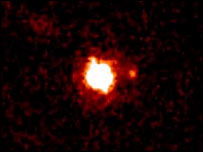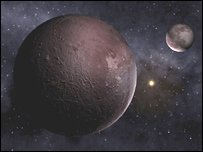
The number of solar system planets will increase
 Pluto planet was discovered in 1930 by American astronomer Clyde Tombaugh (Photo: BBC) A document passed by astronomer in the Prague meeting will be able to make textbooks in high schools and universities learn to rewrite.
Pluto planet was discovered in 1930 by American astronomer Clyde Tombaugh (Photo: BBC) A document passed by astronomer in the Prague meeting will be able to make textbooks in high schools and universities learn to rewrite.
The document suggests that in addition to the eight identified planets, there are three new planets called ' plutons ' and the largest asteroid Ceres.
Pluton stars - Pluto are still a planet, but become the basis for a new group of pluton planets.
This plan was developed by the International Astronomical Society (IAU) with the aim of reviewing the criteria based on which people define planets.
More than 2,500 astronomers will meet at the IAU General Assembly meeting in Prague to vote for this plan next Thursday.
New era
'For the first time in 75 years, we can discover new planets in the solar system. This is a great prospect, ' said Richard Binzel, an IAU member.


Object 2003 UB313 is bigger than Pluto planet (Photo: BBC)
Experts have not yet agreed on the Pluto planet - the farthest and smallest planet compared to the other eight planets - is it considered a planet?
In the early 1990s, astronomers found several objects the same size as Pluto in the outer region of the Solar System called the Kuiper Ring.
Some astronomers believe that Pluto belongs to residents of ' dwarf stars ', not what we call a planet.
With a diameter of 2,360 kilometers, Pluto is smaller than the rest of the planets, but is still considered the largest in the Kuiper Ring until recently, Professor Mike Brown and colleagues at the California Institute of Technology discovered. object 2003 UB313, with a diameter of about 3,000 kilometers, larger than Pluto.
Upgrade stars
The IAU's draft resolution recognizes eight ' classic ' planets as Mercury, Venus, Earth, Mars, Saturn, Jupiter, Uranus, Neptune, and the three-star pluton group as Pluto. king, star Charon, UB313, and asteroid Ceres.
Charon is currently considered a Pluto moon, but in size, some experts consider it a twin planet.
The surprise in the draft is Ceres, because people still give Ceres a meteor. Ceres is the largest object in the belt between Mars and Saturn, and is spherical like a planet.
Through the draft
The basis for re-evaluating the planetary system is a new scientific definition for the planet which takes into account the issue of gravity.
According to this definition, in addition to the planet having to orbit a star rather than a star, it must have enough mass and gravity to shape itself into a sphere.
Professor Gingerich told BBC News he believed the resolution would be passed.
Following this momentum, more distant objects such as Sedna, Orcus, Quaoar and 2003 EL61, and Vesta, Pallas and Hygiea meteors are in the IAU's ' watch list ', which can be considered planets if the Astronomers gain information about their size and trajectory.
IAU is responsible for naming planets and moons since 1919.

- Discover more than 1000 new planets outside the solar system
- Unknown mystery about planets outside the solar system
- Discover more than 700 planets outside the solar system
- Planets in the Solar System
- Discovered 28 new planets outside the solar system
- The distance from the Earth to the celestial bodies in the solar system
- Space Science: The order of 8 (or 9) planets in the Solar System
- NASA announces a map of 4,000 planets outside the Solar System
- Latest images of 7 planets in the Solar System version 2.0
- Discover the oldest solar system outside the solar system
- Detection of the Solar System may contain Earth-like planets
- How the plane took off on the solar system planets
 Van Allen's belt and evidence that the Apollo 11 mission to the Moon was myth
Van Allen's belt and evidence that the Apollo 11 mission to the Moon was myth The levels of civilization in the universe (Kardashev scale)
The levels of civilization in the universe (Kardashev scale) Today Mars, the sun and the Earth are aligned
Today Mars, the sun and the Earth are aligned The Amazon owner announced a secret plan to build a space base for thousands of people
The Amazon owner announced a secret plan to build a space base for thousands of people